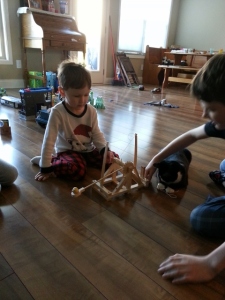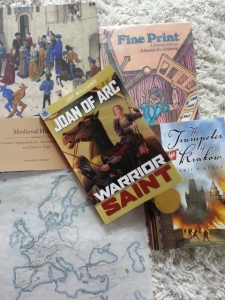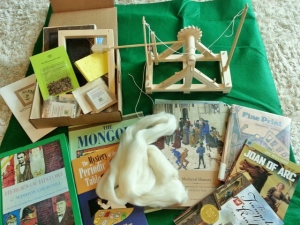
After our delightful study of the Canterbury Tales with Beautiful Feet Books we started studying Joan of Arc and The One Hundred Years’ War between France and England. The story of St. Joan is so very sad. My children were not familiar with her at all and so had no idea of the amazing and heartbreaking story they were about to embark. As we read her story the kids bombarded me with questions…hard questions too! I had to explain the veneration of relics, asking saints for prayers and the nature of visions. As we continued to read her story the kids struggled to understand why she was abandoned by her king, condemned by the church and burned alive.

Of course, the kids really wanted to know if I believed the Maid of Orleans. Did she really have visions? Did God send her to save France from the English? I cannot have an answer for every question and someday they will make up their own minds on such mysteries. I choose to simply accept Joan of Arc at her word.
“Joan was a being so uplifted from the ordinary run of mankind that she finds no equal in a thousand years.” –Winston Churchill
“She is the Wonder of the Ages. And when we consider her origin, her early circumstances, her sex, and that she did all the things upon which her renown rests while she was still a young girl, we recognize that while our race continues she will be also the Riddle of the Ages.” –Mark Twain

While we studied about Joan we built a catapult and looked through a picture book (from the library and I forgot to note the title or take a picture of it!) of medieval warfare tactics and siege engines. The boys built some Lego models (I didn’t take pictures again) and we watched several documentaries on YouTube and Netflix about castles and medieval warfare. Currently Netflix has a series called “Secrets of Great British Castles” that the family enjoys watching together.
We moved on to the study of the printing press, movable type and Johannes Gutenberg. We enjoyed both the book for this section and the recommended Stephen Fry documentary from the guide. We spent time discussing the importance of this moment in history. This invention laid the corner-stone of the Reformation, Renaissance, the scientific revolution and the spread of learning to nearly all people. For this part of the study I bought a paper making kit. We plan to make paper later this week and try our hands at making a homemade book.
 Our last read aloud for these past six weeks was The Trumpeter of Krakow. Oh wow did we love this book!!! It follows the story of a family in the Ukraine that has to travel to Krakow as refugees (a topic still relevant on the news today) and they just happen to be in possession of the philosopher’s stone. Of course the kids were shocked to discover that JK Rowling didn’t come up with the idea all her own!!! We discussed alchemy and the theory that the whomever possessed the stone could turn other metals into gold. While we were reading about the alchemists in the story I pulled out The Mystery of the Periodic Table (by Benjamin D Wiker) and read the couple of chapters on alchemy to my crew.
Our last read aloud for these past six weeks was The Trumpeter of Krakow. Oh wow did we love this book!!! It follows the story of a family in the Ukraine that has to travel to Krakow as refugees (a topic still relevant on the news today) and they just happen to be in possession of the philosopher’s stone. Of course the kids were shocked to discover that JK Rowling didn’t come up with the idea all her own!!! We discussed alchemy and the theory that the whomever possessed the stone could turn other metals into gold. While we were reading about the alchemists in the story I pulled out The Mystery of the Periodic Table (by Benjamin D Wiker) and read the couple of chapters on alchemy to my crew.
We are currently working through a felting project to go along with our studies of the Mongols. Making your very own felt sheets from wool roving is a bit messy! We finally have a nice sunny weekend coming up so that we can work on our paper making and felting projects outside.
We only have four weeks left and our medieval study will be all finished! We’re in the process of making our Robin Hood hats, choosing recipes and other projects for our final feast. We are looking forward to sharing the end of our study celebration with you soon!

April 13, 2016 at 12:13 am
Awesome study unit! We’ve also been learning about Joan of Arc in our history studies. She was truly remarkable and I’m so glad she followered her heart and believed as she did. Looks like you have some fantastic resources. Thanks for sharing. 🙂
LikeLiked by 1 person
April 13, 2016 at 6:07 am
We also watched a great documentary about her on three Brigham Young channel.
LikeLiked by 1 person
April 13, 2016 at 3:30 pm
Cool! We like documentaries. It helps to visualize history.
LikeLiked by 1 person
April 13, 2016 at 7:11 am
Off subject completely, but cute cat! 🙂 🙂
LikeLiked by 1 person
April 13, 2016 at 7:30 am
Oh thanks! That is our kitty Boots.
LikeLike
April 13, 2016 at 7:37 am
:), Mine is a British shorthair named Willbur
LikeLiked by 1 person
April 13, 2016 at 8:38 am
Oh my gosh, I didn’t see that your cat was pulling the string! Did it work! SO CUTE! I love it! #catlover
LikeLiked by 1 person
April 13, 2016 at 5:40 pm
We are starting Diane Stanley’s Joan of Arc tomorrow. I will brace myself for the difficult questions too! 🙂
LikeLiked by 1 person
April 13, 2016 at 6:12 pm
Oh! She is one of my favorites! I did not even know she had a book about St. Joan of Arc.
LikeLike
April 14, 2016 at 3:03 am
My son is learning about the periodic table at the moment and I’ve just put the book you recommended into my Amazon cart! Thanks for the recommendation 🙂
LikeLiked by 1 person
April 14, 2016 at 7:56 am
That book is fabulous and humorous!
LikeLike
April 14, 2016 at 7:43 am
Just a heads up- I put a link from my blog to yours, if you want I can take it off, it is on http://www.thewillburcatblog.wordpress.com
LikeLiked by 1 person
April 14, 2016 at 7:51 am
Oh thank you! I do not mind at all. We are all here to share a bit of ourselves after all.
LikeLike
April 14, 2016 at 7:55 am
🙂 🙂 and God’s word- #dontletthemsilenceyou
LikeLiked by 1 person
April 15, 2016 at 11:12 am
I see you read my Hatshepsut post. Did you like it? Hatshepsut is sort of like Joan in her way of standing up. I love women standing up for rights!
LikeLike